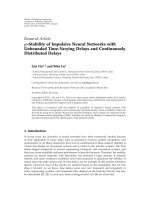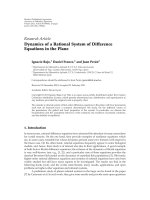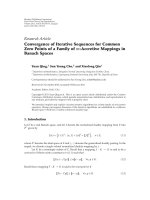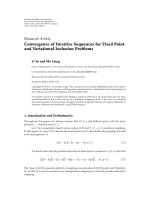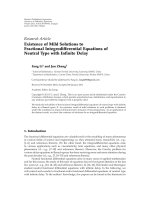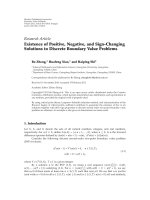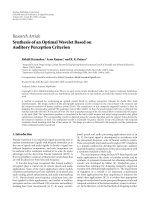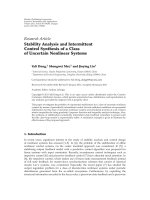Báo cáo hóa học: " Research Article Stability of a Jensen Type Logarithmic Functional Equation on Restricted Domains and Its Asymptotic Behaviors" pdf
Bạn đang xem bản rút gọn của tài liệu. Xem và tải ngay bản đầy đủ của tài liệu tại đây (498.62 KB, 13 trang )
Hindawi Publishing Corporation
Advances in Difference Equations
Volume 2010, Article ID 432796, 13 pages
doi:10.1155/2010/432796
Research Article
Stability of a Jensen Type Logarithmic
Functional Equation on Restricted Domains and
Its Asymptotic Behaviors
Jae-Young Chung
Department of Mathematics, Kunsan National University, Kunsan 573-701, Republic of Korea
Correspondence should be addressed to Jae-Young Chung,
Received 28 June 2010; Revised 30 October 2010; Accepted 25 December 2010
Academic Editor: Roderick Melnik
Copyright q 2010 Jae-Young Chung. This is an open access article distributed under the Creative
Commons Attribution License, which permits unrestricted use, distribution, and reproduction in
any medium, provided the original work is properly cited.
Let
R
be the set of positive real numbers, B a Banach space, f : R
→ B, and >0, p, q,P, Q ∈
R with pqPQ
/
0. We prove the Hyers-Ulam stability of the Jensen type logarithmic functional
inequality fx
p
y
q
− Pfx − Qfy≤ in restricted domains of the form {x, y : x>0,y >
0,x
k
y
s
≥ d} for fixed k, s ∈ R with k
/
0ors
/
0andd>0. As consequences of the results we
obtain asymptotic behaviors of the inequality as x
k
y
s
→∞.
1. Introduction
The stability problems of functional equations have been originated by Ulam in 1940 see
1. One of the first assertions to be obtained is the following result, essentially due to Hyers
2, that gives an answer for the question of Ulam.
Theorem 1.1. Suppose that S, is an additive semigroup, B is a Banach space, ≥ 0, and f : S →
B satisfies the inequality
f
x y
− f
x
− f
y
≤ 1.1
for all x, y ∈ S. Then there exists a unique function A : S → B satisfying
A
x y
A
x
A
y
1.2
2 Advances in Difference Equations
for which
f
x
− A
x
≤ 1.3
for all x ∈ S.
In 1950-1951 this result was generalized by the authors Aoki 3 and Bourgin 4, 5.
Unfortunately, no results appeared until 1978 when Th. M. Rassias generalized the Hyers’
result to a new approximately linear mappings 6. Following the Rassias’ result, a great
number of the papers on the subject have been published concerning numerous functional
equations in various directions 6–16. For more precise descriptions of the Hyers-Ulam
stability and related results, we refer the reader to the paper of Moszner 17. Among the
results, the stability problem in a restricted domain was investigated by Skof, who proved
the stability problem of the inequality 1.1 in a restricted domain 16. Developing this
result, Jung considered the stability problems in restricted domains for the Jensen functional
equation 11 and Jensen type functional equations 14. The results can be summarized as
follows: let X and Y be a real normed space and a real Banach space, respectively. For fixed
d>0, if f : X → Y satisfies the functional inequalities such as that of Cauchy, Jensen and
Jensen type, etc. for all x, y ∈ X with x
y≥d, the inequalities hold for all x, y ∈ X.We
also refer the reader to 18–26 for some interesting results on functional equations and their
Hyers-Ulam stabilities in restricted conditions.
Throughout this paper, we denote by R
the set of positive real numbers, B a Banach
space, f : R
→ B,andp, q, P, Q ∈ R with pqPQ
/
0. We prove the Hyers-Ulam stability of
the Jensen type logarithmic functional inequality
f
x
p
y
q
− Pf
x
− Qf
y
≤ 1.4
in the restricted domains of the form U
k,s
{x, y : x>0,y>0,x
k
y
s
≥ d} for fixed k, s ∈ R
with k
/
0ors
/
0, and d>0. As a result, we prove that if the inequality 1.4 holds for all
x, y ∈ U
k,s
, there exists a unique function L : R
→ B satisfying
L
xy
− L
x
− L
y
0,x,y>0 1.5
for which
f
x
− L
x
− f
1
≤ 4 1.6
for all x>0ifk/p
/
s/q,
f
x
− L
x
− f
1
≤
4
|
P
|
1.7
for all x>0ifs
/
0, and
f
x
− L
x
− f
1
≤
4
|
Q
|
1.8
Advances in Difference Equations 3
for all x>0ifk
/
0. As a consequence of the result we obtain the stability of the inequality
f
px qy
− Pf
x
− Qf
y
≤ 1.9
in the restricted domains of the form {x, y ∈ R
2
: kx sy ≥ d} for fixed k, s ∈ R with k
/
0
or s
/
0, and d ∈ R. Also we obtain asymptotic behaviors of t he inequalities 1.4 and 1.9 as
x
k
y
s
→∞and kx sy →∞, respectively.
2. Hyers-Ulam Stability in Restricted Domains
We call the functions satisfying 1.5 logarithmic functions. As a direct consequence of
Theorem 1.1, we obtain the stability of the logarithmic functional equation, viewing R
, ×
as a multiplicative group see also the result of Forti 9.
Theorem A. Suppose that f : R
→ B, ≥ 0, and
f
xy
− f
x
− f
y
≤ 2.1
for all x, y > 0. Then there exists a unique logarithmic function L : R
→ B satisfying
f
x
− L
x
≤ 2.2
for all x>0.
We first consider the usual logarithmic functional inequality 2.1 in the restricted
domains U
k,s
.
Theorem 2.1. Let , d > 0, k, s ∈ R with k
/
0 or s
/
0. Suppose that f : R
→ B satisfies
f
xy
− f
x
− f
y
≤ 2.3
for all x, y > 0,withx
k
y
s
≥ d. Then there exists a unique logarithmic function L : R
→ B such
that
f
x
− L
x
≤ 3 2.4
for all x ∈ R
.
4 Advances in Difference Equations
Proof. From the symmetry of the inequality we may assume that s
/
0. For given x, y ∈ R
,
choose a z>0 such that x
k
y
k
z
s
≥ d, x
k
y
s
z
s
≥ d,andy
k
z
s
≥ d. Then we have
f
xy
− f
x
− f
y
≤
−f
xyz
f
xy
f
z
f
xyz
− f
x
− f
yz
f
yz
− f
y
− f
z
≤ 3.
2.5
This completes the proof.
Now we consider the Hyers-Ulam stability of the Jensen type logarithmic functional
inequality 1.4 in the restricted domains U
k,s
.
Theorem 2.2. Let , d > 0,k,s∈ R,k/p
/
s/q. Suppose that f : R
→ B satisfies
f
x
p
y
q
− Pf
x
− Qf
y
≤ 2.6
for all x, y > 0,withx
k
y
s
≥ d. Then there exists a unique logarithmic function L : R
→ B such
that
f
x
− L
x
− f
1
≤ 4 2.7
for all x ∈ R
.
Proof. Replacing x by x
1/p
, y by y
1/q
in 2.6 we have
f
xy
− Pf
x
1/p
− Qf
y
1/q
≤ 2.8
for all x, y > 0, with x
k/p
y
s/q
≥ d.
For given x, y ∈ R
, choose a z>0 such that x
k/p
y
s/q
z
s/q−k/p
≥ d, x
k/p
z
s/q−k/p
≥ d,
y
s/q
z
s/q−k/p
≥ d,andz
s/q−k/p
≥ d. Replacing x by xz
−1
, y by yz; x by xz
−1
, y by z; x by z
−1
, y
by yz; x by z
−1
, y by z in 2.8 we have
f
xy
− f
x
− f
y
f
1
≤
f
xy
− Pf
x
1/p
z
−1/p
− Qf
yz
1/q
−f
x
Pf
x
1/p
z
−1/p
Qf
z
1/q
−f
y
Pf
z
−1/p
Qf
yz
1/q
f
1
− Pf
z
−1/p
− Qf
z
1/q
≤ 4.
2.9
Advances in Difference Equations 5
Now by Theorem A, there exists a unique logarithmic function L : R
→ B such that
f
x
− L
x
− f
1
≤ 4 2.10
for all x ∈ R
. This completes the proof.
As a matter of fact, we obtain that L 0inTheorem 2.2 provided that p
/
P and p or P
is a rational number, or q
/
Q and q or Q is a rational number.
Theorem 2.3. Let , d > 0, k, s ∈ R, k/p
/
s/q. Suppose that p
/
P and p or P is a rational number,
or q
/
Q and q or Q is a rational number, and f : R
→ B satisfies
f
x
p
y
q
− Pf
x
− Qf
y
≤ 2.11
for all x, y > 0,withx
k
y
s
≥ d. Then one has
f
x
− f
1
≤ 4 2.12
for all x ∈ R
.
Proof. We prove 2.12 only for the case that p
/
P and p or P is a rational number since the
other case is similarly proved. From 2.7 and 2.11, using the triangle inequality we have
L
x
p
y
q
− PL
x
− QL
y
≤ M 2.13
for all x, y > 0, with x
k
y
s
≥ d, where M 5 4|P| 4|Q||f11 − P − Q|.Ifk
/
0, putting
y 1in2.13 we have
L
x
p
− PL
x
≤ M 2.14
for all x>0, with x
k
≥ d.ItiseasytoseethatLx
r
rLx for all x>0 and all rational
numbers r.Thusifp is a rational number, it follows from 2.14 that
L
x
≤
M
p − P
2.15
for all x>0, with x
k
≥ d. If there exists x
0
> 0 such that Lx
0
/
0, we can choose a rational
number r such that x
rk
0
≥ d and rLx
0
>M/|p − P| it is realized when r is large if x
k
0
> 1,
and when −r is large if x
k
0
< 1. Now we have
M
p − P
<
rL
x
0
L
x
r
0
≤
M
p − P
.
2.16
6 Advances in Difference Equations
Thus it follows that L 0. If P is a rational number, it follows from 2.14 that
L
x
p−P
≤ M 2.17
for all x>0, with x
k
≥ d, which implies
L
x
≤ M 2.18
for all x>0, with x
k/p−P
≥ d. Similarly, using 2.18 we can show that L 0. If k 0,
choosing y
0
> 0 such that y
s
0
≥ d, putting y y
0
in 2.13 and using the triangle inequality
we have
L
x
p
− PL
x
≤ M
L
y
q
0
− QL
y
0
2.19
for all x>0. Similarly, using 2.19 we can show that L 0. Thus the inequality 2.12 follows
from 2.7. T his completes the proof.
Theorem 2.4. Let , d > 0,k,s∈ R with k
/
0 or s
/
0. Suppose that f : R
→ B satisfies
f
x
p
y
q
− Pf
x
− Qf
y
≤ 2.20
for all x, y > 0,withx
k
y
s
≥ d. Then there exists a unique logarithmic function L : R
→ B such
that
f
x
− L
x
− f
1
≤
4
|
P
|
2.21
for all x ∈ R
if s
/
0, and
f
x
− L
x
− f
1
≤
4
|
Q
|
2.22
for all x ∈ R
if k
/
0.
Advances in Difference Equations 7
Proof. Assume that s
/
0. For given x, y ∈ R
, choose a z>0 such that x
k
y
k
z
s
≥ d, x
k
y
ps/q
z
s
≥
d, y
k
z
s
≥ d and y
ps/q
z
s
≥ d. Replacing x by xy, y by z; x by x, y by y
p/q
z; x by y, y by z; x
by 1, y by y
p/q
z in 2.20 we have
Pf
xy
− Pf
x
− Pf
y
Pf
1
≤
−f
xy
p
z
q
Pf
xy
Qf
z
f
xy
p
z
q
− Pf
x
− Qf
y
p/q
z
f
y
p
z
q
− Pf
y
− Qf
z
−f
y
p
z
q
Pf
1
Qf
y
p/q
z
≤ 4.
2.23
Dividing 2.23 by |P | and using Theorem A, we obtain that there exists a unique logarithmic
function L : R
→ B such that
f
x
− L
x
− f
1
≤
4
|
P
|
2.24
for all x ∈ R
. Assume that k
/
0. For given x, y ∈ R
, choose a z>0 such that x
s
y
s
z
k
≥
d, x
qk/p
y
s
z
k
≥ d, x
s
z
k
≥ d and x
qk/p
z
k
≥ d. Replacing y by xy, x by z; y by y, x by x
q/p
z; y
by x, x by z; y by 1, x by x
q/p
z in 2.20 we have
Qf
xy
− Qf
x
− Qf
y
Qf
1
≤
−f
xy
q
z
p
Pf
z
Qf
xy
f
xy
q
z
p
− Pf
x
q/p
z
− Qf
y
f
x
q
z
p
− Pf
z
− Qf
x
−f
x
q
z
p
Pf
x
q/p
z
Qf
1
≤ 4.
2.25
Dividing 2.25 by |Q| and using Theorem A, we obtain that there exists a unique logarithmic
function L : R
→ B such that
f
x
− L
x
− f
1
≤
4
|
Q
|
2.26
for all x ∈ R
. This completes the proof.
From Theorem 2.4, using the same approach as in the proof of Theorem 2.3 we have
the following.
8 Advances in Difference Equations
Theorem 2.5. Let , d > 0, k, s ∈ R with k
/
0 or s
/
0. Suppose that p
/
P and p or P is a rational
number, or q
/
Q and q or Q is a rational number, and f : R
→ B satisfies
f
x
p
y
q
− Pf
x
− Qf
y
≤ 2.27
for all x, y > 0,withx
k
y
s
≥ d. Then one has
f
x
− f
1
≤
4
|
P
|
2.28
for all x ∈ R
if s
/
0, and
f
x
− f
1
≤
4
|
Q
|
2.29
for all x ∈ R
if k
/
0.
We call A : R → B an additive function provided that
A
x y
A
x
A
y
2.30
for all x, y ∈ R.UsingTheorem 2.2 we have the following.
Corollary 2.6 see 22. Let >0, d, k, s ∈ R with k/p
/
s/q. Suppose that g : R → B satisfies
g
px qy
− Pg
x
− Qg
y
≤ 2.31
for all x, y ∈ R,withkx sy ≥ d
. Then there exists a unique additive function A : R → B such that
g
x
− A
x
− g
0
≤ 4 2.32
for all x ∈ R.
Proof. Replacing x by ln u, y by ln v in 2.31 and setting fxgln x we have
f
u
p
v
q
− Pf
u
− Qf
v
≤ 2.33
for all u, v ∈ R,withu
k
v
s
≥ e
d
.UsingTheorem 2.2, we have
f
x
− L
x
− f
1
≤ 4 2.34
for all x ∈ R
, which implies
g
x
− L
e
x
− g
0
≤ 4 2.35
for all x ∈ R. Letting AxLe
x
we get the result.
Advances in Difference Equations 9
Using Theorem 2.3, we have the following.
Corollary 2.7. Let >0, d, k, s ∈ R with k/p
/
s/q. Suppose that p
/
P and p or P is a rational
number, or q
/
Q and q or Q is a rational number, and g : R → B satisfies
g
px qy
− Pg
x
− Qg
y
≤ 2.36
for all x, y ∈ R,withkx sy ≥ d. Then one has
g
x
− g
0
≤ 4 2.37
for all
x ∈ R.
Using Theorem 2.4, we have the following.
Corollary 2.8. Let >0, d, k, s ∈ R with k
/
0 or s
/
0. Suppose that g : R → B satisfies
g
px qy
− Pg
x
− Qg
y
≤ 2.38
for all x, y ∈ R,withkx sy ≥ d. Then there exists a unique additive function A : R → B such that
g
x
− A
x
− g
0
≤
4
|
P
|
2.39
for all x ∈ R if s
/
0, and
g
x
− A
x
− g
0
≤
4
|
Q
|
2.40
for all x ∈ R if k
/
0.
Using Theorem 2.5, we have the following.
Corollary 2.9. Let >0, d, k, s ∈ R with k
/
0 or s
/
0. Suppose that p
/
P and p or P is a rational
number, or q
/
Q and q or Q is a rational number, and g : R → B satisfies
g
px qy
− Pg
x
− Qg
y
≤ 2.41
for all x, y ∈ R,withkx sy ≥ d. Then one has
g
x
− g
0
≤
4
|
P
|
2.42
for all x ∈ R if s
/
0, and
g
x
− g
0
≤
4
|
Q
|
2.43
for all x ∈ R if k
/
0.
10 Advances in Difference Equations
3. Asymptotic Behavior of the Inequality
In this section, we consider asymptotic behaviors of the inequalities 1.4 and 2.1.
Theorem 3.1. Let k, s ∈ R satisfy one of the conditions; k
/
0, s
/
0. Suppose that f : R
→ B
satisfies the asymptotic condition
f
xy
− f
x
− f
y
−→ 0 3.1
as x
k
y
s
→∞.Thenf is a logarithmic function.
Proof. By the condition 3.1, for each n ∈ N, there exists d
n
> 0 such that
f
xy
− f
x
− f
y
≤
1
n
3.2
for all x, y > 0, with x
k
y
s
≥ d
n
.ByTheorem 2.1, there exists a unique logarithmic function
L
n
: R
→ B such that
f
x
− L
n
x
≤
3
n
3.3
for all x ∈ R
.From3.4 we have
L
n
x
− L
m
x
≤
3
n
3
m
≤ 6
3.4
for all x ∈ R
and all positive integers n, m. Now, the inequality 3.4 implies L
n
L
m
. Indeed,
for all x>0 and rational numbers r>0 we have
L
n
x
− L
m
x
1
r
L
n
x
r
− L
m
x
r
≤
6
r
.
3.5
Letting r →∞in 3.5, we have L
n
L
m
. Thus, letting n →∞in 3.3, we get the result.
Theorem 3.2. Let k, s ∈ R satisfy one of the conditions; k
/
0, s
/
0, k/p
/
s/q. Suppose that f :
R
→ B satisfies the asymptotic condition
f
x
p
y
q
− Pf
x
− Qf
y
−→ 0 3.6
as x
k
y
s
→∞. Then there exists a unique logarithmic function L : R
→ B such that
f
x
L
x
f
1
3.7
for all x ∈ R
.
Advances in Difference Equations 11
Proof. By the condition 3.6, for each n ∈ N, there exists d
n
> 0 such that
f
x
p
y
q
− Pf
x
− Qf
y
≤
1
n
3.8
for all x, y > 0, with x
k
y
s
≥ d
n
. By Theorems 2.2 and 2.4, there exists a unique logarithmic
function L
n
: R
→ B such that
f
x
− L
n
x
− f
1
≤
4
n
3.9
if k/p
/
s/q,
f
x
− L
n
x
− f
1
≤
4
n
|
P
|
3.10
if s
/
0, and
f
x
− L
n
x
− f
1
≤
4
n
|
Q
|
3.11
if k
/
0. For all cases 3.9, 3.10,and3.11, there exists M>0 such that
L
n
x
− L
m
x
≤ M 3.12
for all x ∈ R
and all positive integers n, m. Now as in the proof of Theorem 3.1, it follows
from 3.12 that L
n
L
m
for all n, m ∈ N. Letting n →∞in 3.9, 3.10,and3.11 we get the
result.
Similarly using Theorems 2.3 and 2.5,wehavethefollowing.
Theorem 3.3. Let k, s ∈ R satisfy one of the conditions; k
/
0, s
/
0, k/p
/
s/q. Suppose that p
/
P
and p or P is a rational number, or q
/
Q and q or Q is a rational number, and f : R
→ B satisfies
the asymptotic condition
f
x
p
y
q
− Pf
x
− Qf
y
−→ 0 3.13
as x
k
y
s
→∞.Thenf is a constant function.
12 Advances in Difference Equations
Using Corollaries 2.6 and 2.8 we have the following.
Corollary 3.4. Let >0, k, s ∈ R satisfy one of the conditions k
/
0, s
/
0,ork/p
/
s/q. Suppose
that g : R → B satisfies
g
px qy
− Pg
x
− Qg
y
−→ 0 3.14
as kx sy →∞. Then there exists a unique additive function A : R → B such that
g
x
A
x
g
0
3.15
for all x ∈ R.
Using Corollaries 2.7 and
2.9 we have the following.
Corollary 3.5. Let >0, k, s ∈ R satisfy one of the conditions k
/
0, s
/
0,ork/p
/
s/q. Suppose
that p
/
P and p or P is a rational number, or q
/
Q and q or Q is a rational number, and g : R → B
satisfies
g
px qy
− Pg
x
− Qg
y
−→ 0 3.16
as kx sy →∞.Theng is a constant function.
Acknowledgments
The author expresses his sincere gratitude to a referee of the paper for many useful comments
and introducing the interesting related recent results including the papers 17–26.Thiswork
was supported by Basic Science Research Program through the National Research Foundation
of Korea NRF funded by the Ministry of Education, Science and Technology MESTno.
2010-0016963.
References
1 S. M. Ulam, A Collection of Mathematical Problems, Interscience, New York, NY, USA, 1960.
2 D. H. Hyers, “On the stability of the linear functional equation,” Proceedings of the National Academy of
Sciences of the United States of America, vol. 27, pp. 222–224, 1941.
3 T. Aoki, “On the stability of the linear transformation in Banach spaces,” Journal of the Mathematical
Society of Japan, vol. 2, pp. 64–66, 1950.
4 D. G. Bourgin, “Multiplicative transformations,” Proceedings of the National Academy of Sciences of the
United States of America, vol. 36, pp. 564–570, 1950.
5 D. G. Bourgin, “Classes of transformations and bordering transformations,” Bulletin of the American
Mathematical Society, vol. 57, pp. 223–237, 1951.
6 T. M. Rassias, “On the stability of the linear mapping in Banach spaces,” Proceedings of the American
Mathematical Society, vol. 72, no. 2, pp. 297–300, 1978.
7 J. Chung, “A distributional version of functional equations and their stabilities,” Nonlinear Analysis:
Theory, Methods & Applications, vol. 62, no. 6, pp. 1037–1051, 2005.
8 J. Chung, “Stability of approximately quadratic Schwartz distributions,” Nonlinear Analysis: Theory,
Methods & Applications, vol. 67, no. 1, pp. 175–186, 2007.
Advances in Difference Equations 13
9 G. L. Forti, “The stability of homomorphisms and amenability, with applications to functional
equations,” Abhandlungen aus dem Mathematischen Seminar der Universit
¨
at Hamburg, vol. 57, pp. 215–
226, 1987.
10 D. H. Hyers, G. Isac, and T. M. Rassias, Stability of Functional Equations in Several Variables, vol. 34 of
Progress in Nonlinear Differential Equations and their Applications,Birkh
¨
auser, Boston, Mass, USA, 1998.
11 S M. Jung, “Hyers-Ulam-Rassias stability of Jensen’s equation and its application,” Proceedings of the
American Mathematical Society, vol. 126, no. 11, pp. 3137–3143, 1998.
12 K W. Jun and H M. Kim, “Stability problem for Jensen-type functional equations of cubic
mappings,” Acta Mathematica Sinica, vol. 22, no. 6, pp. 1781–1788, 2006.
13 G. H. Kim and Y. W. Lee, “Boundedness of approximate trigonometric functional equations,” Applied
Mathematics Letters, vol. 31, no. 4, pp. 439–443, 2009.
14 J. M. Rassias, “On the Ulam stability of mixed type mappings on restricted domains,” Journal of
Mathematical Analysis and Applications, vol. 276, no. 2, pp. 747–762, 2002.
15 J. M. Rassias and M. J. Rassias, “On the Ulam stability of Jensen and Jensen type mappings on
restricted domains,” Journal of Mathematical Analysis and Applications, vol. 281, no. 2, pp. 516–524,
2003.
16 F. Skof, “Sull’approssimazione delle applicazioni localmente δ-additive,” Atti della Reale Accademia
delle Scienze di Torino. Classe di Scienze Fisiche, Matematiche e Naturali, vol. 117, pp. 377–389, 1983.
17 Z. Moszner, “On the stability of functional equations,” Aequationes Mathematicae, vol. 77, no. 1-2, pp.
33–88, 2009.
18 B. Batko, “Stability of an alternative functional equation,” Journal of Mathematical Analysis and
Applications, vol. 339, no. 1, pp. 303–311, 2008.
19 B. Batko, “On approximation of approximate solutions of Dhombres’ equation,” Journal of
Mathematical Analysis and Applications, vol. 340, no. 1, pp. 424–432, 2008.
20 J. Brzde¸k, “On the quotient stability of a family of functional equations,” Nonlinear Analysis: Theory,
Methods & Applications, vol. 71, no. 10, pp. 4396–4404, 2009.
21 J. Brzde¸k, “On a method of proving the Hyers-Ulam stability of functional equations on restricted
domains,” The Australian J ournal of Mathematical Analysis and Applications, vol. 6, no. 1, pp. 1–10, 2009.
22 J. Brzde¸k, “On stability of a family of functional equations,” Acta Mathematica Hungarica, vol. 128, no.
1-2, pp. 139–149, 2010.
23 J. Brzde¸k and J. Sikorska, “A conditional exponential functional equation and its stability,” Nonlinear
Analysis: Theory, Methods & Applications, vol. 72, no. 6, pp. 2923–2934, 2010.
24 J. Sikorska, “On two conditional Pexider functional equations and their stabilities,” Nonlinear Analysis:
Theory, Methods & Applications, vol. 70, no. 7, pp. 2673–2684, 2009.
25 J. Sikorska, “On a Pexiderized conditional exponential functional equation,” Acta Mathematica
Hungarica, vol. 125, no. 3, pp. 287–299, 2009.
26 J. Sikorska, “Exponential functional equation on spheres,” Applied Mathematics Letters, vol. 23, no. 2,
pp. 156–160, 2010.
